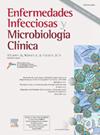急诊科抗菌药物使用指标比较
IF 2.5
4区 医学
Q3 INFECTIOUS DISEASES
Enfermedades infecciosas y microbiologia clinica
Pub Date : 2025-10-01
DOI:10.1016/j.eimc.2025.01.009
引用次数: 0
摘要
由于现有指标种类繁多,监测急诊科抗菌药物的使用是复杂的。我们评估了用于评估这些单位抗菌药物使用的各种指标之间的差异。方法回顾性分析2019-2024年急诊收治的所有成年患者的行政资料。汇总的季度数据包括治疗患者百分比、DDDs/100次入院、DDD/100例患者日和DOT/100次入院。采用自回归综合移动平均(ARIMA)模型研究DDD/100入院率与其他抗菌药物使用指标之间的关系。以DDDs/100例入院患者计算的年度抗菌药物使用中位数为11.7 (IQR为10.8-12.4)。当比较头孢菌素、林肯胺类药物和碳青霉烯类药物的DDD/100入院人数和DDD/100患者日时,发现抗菌药物消费相关性存在显著差异。亚胺培南、克林霉素、哌拉西林-他唑巴坦、庆大霉素和万古霉素的DDD和DOT比较差异有统计学意义。结论DDDs和DOTs测量的抗菌药物总体使用情况是一致的,但多剂量抗生素的相关性可能存在差异。DDD/100入院人数是一个合适的指标,但补充DDD/100患者日、DOT和接受抗生素治疗的患者百分比为监测抗菌药物使用提供了有价值的信息。本文章由计算机程序翻译,如有差异,请以英文原文为准。
Comparison of antimicrobial consumption indicators in the emergency department
Background
Monitoring antimicrobial use in the emergency department is complex due to the wide variety of existing indicators. We evaluated the differences between various indicators used to evaluate antimicrobial use in these units.
Methods
Retrospective analysis of administrative data from all adult patients admitted to an emergency unit (2019–2024). Aggregated quarterly data included the percentage of patients treated, DDDs/100 admissions, DDD/100 patients-day and DOT/100 admissions. An autoregressive integrated moving average (ARIMA) model was used to investigate the association between DDD/100 admissions and the other antimicrobial use indicators.
Findings
Annual median antimicrobial drug use measured by DDDs/100 admissions was 11.7 (IQR 10.8–12.4). Significant differences in antimicrobial consumption correlation were noted when comparing DDD/100 admissions and DDD/100 patient-days for cephalosporins, lincosamides, and carbapenems. Significant differences in the comparison between DDD and DOT were found for imipenem, clindamycin, piperacillin–tazobactam, gentamicin, and vancomycin.
Conclusions
Aggregate antimicrobial use measured by DDDs or DOTs is consistent, though discrepancies in correlation may occur for antibiotics with multiple daily doses. DDD/100 admissions is a suitable indicator, but complementing it with DDD/100 patient-days, DOT, and percentage of patients receiving antibiotics provides valuable information for monitoring antimicrobial use.
求助全文
通过发布文献求助,成功后即可免费获取论文全文。
去求助
来源期刊
CiteScore
2.10
自引率
8.00%
发文量
194
审稿时长
29 days
期刊介绍:
Hoy está universalmente reconocida la renovada y creciente importancia de la patología infecciosa: aparición de nuevos agentes patógenos, de cepas resistentes, de procesos con expresión clínica hasta ahora desconocida, de cuadros de una gran complejidad. Paralelamente, la Microbiología y la Infectología Clínicas han experimentado un gran desarrollo como respuesta al reto planteado por la actual patología infecciosa. Enfermedades Infecciosas y Microbiología Clínica es la Publicación Oficial de la Sociedad Española SEIMC. Cumple con la garantía científica de esta Sociedad, la doble función de difundir trabajos de investigación, tanto clínicos como microbiológicos, referidos a la patología infecciosa, y contribuye a la formación continuada de los interesados en aquella patología mediante artículos orientados a ese fin y elaborados por autores de la mayor calificación invitados por la revista.

 求助内容:
求助内容: 应助结果提醒方式:
应助结果提醒方式:


